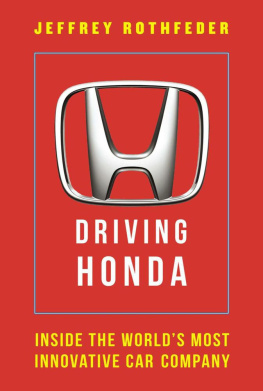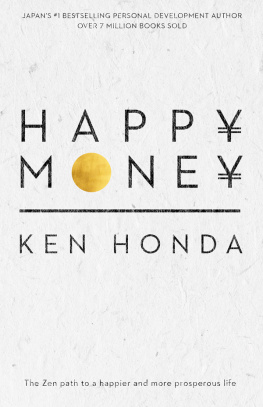Jeffrey Rothfeder - Driving Honda: Inside the Worlds Most Innovative Car Company
Here you can read online Jeffrey Rothfeder - Driving Honda: Inside the Worlds Most Innovative Car Company full text of the book (entire story) in english for free. Download pdf and epub, get meaning, cover and reviews about this ebook. year: 2014, publisher: Portfolio Hardcover, genre: Romance novel. Description of the work, (preface) as well as reviews are available. Best literature library LitArk.com created for fans of good reading and offers a wide selection of genres:
Romance novel
Science fiction
Adventure
Detective
Science
History
Home and family
Prose
Art
Politics
Computer
Non-fiction
Religion
Business
Children
Humor
Choose a favorite category and find really read worthwhile books. Enjoy immersion in the world of imagination, feel the emotions of the characters or learn something new for yourself, make an fascinating discovery.
- Book:Driving Honda: Inside the Worlds Most Innovative Car Company
- Author:
- Publisher:Portfolio Hardcover
- Genre:
- Year:2014
- Rating:4 / 5
- Favourites:Add to favourites
- Your mark:
Driving Honda: Inside the Worlds Most Innovative Car Company: summary, description and annotation
We offer to read an annotation, description, summary or preface (depends on what the author of the book "Driving Honda: Inside the Worlds Most Innovative Car Company" wrote himself). If you haven't found the necessary information about the book — write in the comments, we will try to find it.
Since its birth as a motorcycle company in 1949, Honda has steadily grown into the worlds fifth largest automaker and top engine manufacturer, as well as one of the most beloved, most profitable, and most consistently innovative multinational corporations. What drives the company that keeps creating and improving award-winning and bestselling models like the Civic, Accord, Odyssey, CR-V, and Pilot?
According to Jeffrey Rothfeder, what truly distinguishes Honda from its competitors, especially archrival Toyota, is a deep commitment to a set of unorthodox management tenets. The Honda Way, as insiders call it, is notable for decentralization over corporate control, simplicity over complexity, experimentation over Six Sigmadriven efficiency, and unyielding cynicism toward the status quo and whatever is assumed to be the truth. Honda believes in freely borrowing from the past as a bridge to innovative discontinuity in the present. And those are just a few of the ideas that the companys colorful founder, Soichiro Honda, embedded in the DNA of his start-up sixty-five years ago.
As the first journalist allowed behind Hondas infamously private doors, Rothfeder interviewed dozens of executives, engineers, and frontline employees about its management practices and global strategy. He shows how the company has developed and maintained its unmatched culture of innovation, resilience, and flexibilityand how it exported that culture to other countries that are strikingly different from Japan, establishing locally controlled operations in each region where it lays down roots.
For instance, Rothfeder reports on life at a Honda factory in the tiny town of Lincoln, Alabama, and what happened when American workers were trained to follow the Honda Way, as a self-sufficient outpost of the global company. Could they master Hondas three core principles:
- Embrace Paradox: Honda encourages respectful disagreement and debate between opposing viewpoints, on matters large and small. New ideas often emerge from conflict.
- Real Place, Real Part, Real Knowledge: Honda teaches people to argue using facts, not assumptions. One must go to the factory floor, the showroom, the parking lot, the drivers seat, or the truck bedwhatever it takesto get the facts and make a decision that can be supported with data.
- Respect Individualism: Honda often hires people with unusual backgrounds and independent streaks. It promotes those who question the status quo and who would probably struggle in organizations that focus on rigid rules and systems.
Rothfeder shows how the Alabama plant became a new model for manufacturing in America. It can turn out several different types of cars on any given day and up to 300,000 vehicles and engines a year. Its flexible model enables unparalleled responsiveness to market changes and recovery from mistakes.
As Soichiro Honda himself liked to say, Success can be achieved only through repeated failure and introspection. In fact, success represents one percent of your work, which results only from the ninety-nine percent that is called failure.
Jeffrey Rothfeder: author's other books
Who wrote Driving Honda: Inside the Worlds Most Innovative Car Company? Find out the surname, the name of the author of the book and a list of all author's works by series.











